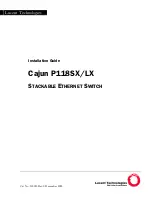
150-319-151-01, Revision 01
Provisioning
HLU-319 List 5A
September 17, 1999
25
DS1 Line Code Option
The DS1 line code option should always be set to conform to the type of DS1 service (AMI or B8ZS) being
provided by the HiGain system. The AUTO mode, which can adapt to either AMI or B8ZS, should only be used
in applications that require it (such as when HiGain acts as a standby circuit to DS1 circuits whose line codes are
not known or may be both AMI and B8ZS). This is because the AUTO mode induces one BPV in the DS1 bit
stream whenever it switches from AMI to B8ZS. The AUTO mode allows both the HLU and the HRU to set its
T1 output code to that which is being received at the opposite end’s T1 input. This forces the input and the output
codes in each direction of transmission to be identical. In the AUTO mode of older HiGain units, the output code
was determined by the input code being received at the local T1 input port instead of at the distant end. The HLU
reverts to this older code setting technique when it is not connected to an HRU-402 or HRU-411.
Margin Alarm Threshold Option
To set the Margin Alarm Threshold:
1
Select
from the System Settings Main Menu screen.
2
Enter the desired minimum acceptable alarm threshold from the 0 to 15 dB range. This causes a system alarm
to occur if either the margin on HDSL Loop 1 (MAL1) or Loop 2 (MAL2) drops below the selected threshold
value.
HAIS Option
The HAIS option provides two selections for the T1 transmit outputs at both the HLU-319 and HRU for HDSL
loss of sync conditions.
•
1LP
causes the AIS (LOS if ALMP is set to LOS) pattern to be transmitted at both T1 outputs when either
of the two HDSL loops experience an out-of-sync (LOSW) condition or when a margin alarm occurs. 1LP
causes the 12 channels on the surviving loop to be lost as they are replaced by the AIS/LOS pattern. However,
it does notify downstream and upstream equipment of the loss of one HDSL loop or a loop with low margin.
This is the preferred setting for initiating an AIS/LOS state with just one conductor open in either of the
HDSL pairs. Short loops, below approximately 16 dB of loss at 200 kHz, can remain in sync with one
conductor open. Since the loop is still in sync, no LOSW condition occurs. However, the margin on a
one-conductor loop drops from 5 to 10 dB. Therefore, if the Margin alarm is set to 5 dB below the normal
margin at turn-up, when one conductor does open, a system alarm occurs and causes the AIS/LOS condition.
This alerts the maintenance personnel of the problem.
•
2LP
requires both HDSL loops to be out of sync (LOSW) before the HAIS signal is transmitted. 2LP
preserves the integrity of the 12 surviving channels when just one loop is lost.
HDSL Line Voltage Options
The PWRF option has four settings for HDSL line power feed:
DIS, LOW, AUTO,
and
HIGH
.
•
DIS
disables any voltage from being applied to the HDSL cable pairs. It is useful to prevent craft personnel
from being exposed to the HDSL line voltage when they are working on the cable pairs.
•
LOW
limits the HDSL simplex voltage to -140 Vdc maximum. This is the standard voltage used in all
non-doubler applications and has no effects in these applications. It can be chosen to limit line-powered,
single-doubler circuits or locally-powered, two-doubler circuits up to -140 Vdc, if the appropriate HiGain
products (HDU-409, HDU-404 or HDU-407 and HRU-402 or HRU-411) are used along with the
Since the margin can never drop below zero, choosing
(zero) for the margin threshold turns
the margin alarm off.
3
3
















































